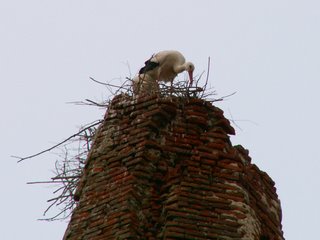White Storks are tall (1 m., 2.3-4.4 kg) long-necked wading birds with long bare red legs and a straight pointed red bill. The white plumage of the head, neck, and body contrasts with the black wing feathers highlighted with a sheen of purple and green iridescence. A small patch of bare black skin surrounds their brown eyes. Sexes are similar in appearance, though males are slightly larger.
Diet:
White Storks are highly opportunistic feeders who will consume a wide variety of prey items including insects, frogs, toads, tadpoles, fish, rodents, snakes, lizards, earthworms, mollusks, crustaceans, and, rarely, the chicks or eggs of ground-nesting birds. Foraging storks search for prey visually while walking deliberately with bill pointed toward the ground. When prey is spotted, they cock their necks back, then jab the bill forward to grasp their victim.
White Storks form loose informal colonies while breeding. Several pairs may nest closely together within sight and sound of one another while appearing completely oblivious to their neighbors. Though storks form monogamous pairs for the duration of the breeding season, they do not migrate or over-winter together. If the same pair reforms in successive years it is largely due to their strong attachment to their nest site.
Males usually arrive at the nest-site first. A male will greet a newly arriving female with the Head-Shaking Crouch display, as he lowers himself on the nest into the incubating posture, erects his neck ruff and shakes his head from side to side. If the male accepts the new arrival as his mate they will cement their pair bond with an Up-Down display. In this display the birds hold their wings away from their sides and pump their heads up and down. This is often accompanied by bill-clattering.
Nests are huge and bulky, constructed of branches and sticks and lined with twigs, grasses, sod, rags, and paper. Particularly old nests have grown to over 2 m in diameter and nearly 3 m in depth. Some nests have been in continuous use for hundreds of years. Both sexes participate in nest construction with the male bringing most of the material.
European Storks have been building their nests on man-made structures since the Middle Ages. They can be found on rooftops, towers, chimneys, telephone-poles, walls, haystacks, and specially constructed nest towers. Many homeowners will add embellishments such as wooden wagon wheels to old chimneys to encourage storks to nest on their houses. Nests can also be found in trees, on cliff-ledges, or occasionally on the ground.
The female usually lays 3-5 eggs, more rarely up to seven. Parents share incubation duties for 33-34 days. Young chicks are covered with white down and have black bills. Both parents feed the young on the nest until they fledge at 8-9 weeks of age. Fledglings may continue to return to the nest site each evening to beg for food from their parents. Young birds reach sexual maturity in their fourth year. Banding records indicate that wild birds can live and reproduce successfully past 30 years of age.
taken from Smithsonian National Zoological Park




1 comentário:
Excelente Blog!!!A Natureza sempre em primeiro lugar!!!
Enviar um comentário